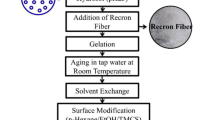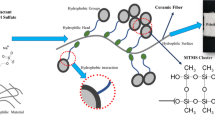Abstract
Silica aerogels exhibit considerable potential for thermal insulation applications owing to their low thermal conductivity. However, they generally possess poor mechanical properties and need to be mechanically enhanced while maintaining their low thermal conductivity. In this study, commercial fumed silica and methyltrimethoxysilane were used as the silica sources and water and ethanol were used as solvents to form a slurry. Consequently, silica aerogel monoliths (SAMs) were prepared through ambient drying without additional surface modification or solvent replacement. The resulting SAM maintained a typical nanopore structure and exhibited low density (0.24 g cm−3), shrinkage (4%), and thermal conductivity (0.046 W m−1 K−1). The slurry was impregnated with fiber blankets via roller pressing, and silica aerogel blankets (SABs) were prepared through thermal solidification of the slurry and ambient drying. The prepared SABs exhibited good flexibility and mechanical properties, facilitating their installation and application for thermal insulation and considerably reducing production cycles and costs. In addition, controlling the particle size and mass fraction of opacifiers decreased the high-temperature thermal conductivities of SABs owing to the nanopore structure and low shrinkage of SAMs, and the thermal conductivity of the optimized SAB at 800°C was as low as 0.054 W m−1 K−1.

摘要
二氧化硅气凝胶由于其低导热率在隔热应用方面具有巨大的潜 力. 然而, 它们通常具有较差的机械性能, 需要在保持低热导率的同时 增强机械性能. 本研究以商业化气相二氧化硅和甲基三甲氧基硅烷为 硅源, 并以水和乙醇为溶剂形成浆料. 基于此, 二氧化硅气凝胶块体 (SAMs)可通过常压干燥进行制备, 且无需额外的表面改性或溶剂置换. 制备的SAMs保持了典型的纳米孔结构, 具有低密度(0.24 g cm−3)、收 缩率(4%)和热导率(0.046 W m−1 K−1). 通过辊压将浆料浸渍到纤维毡 中, 并通过浆料热固化和常压干燥制备出二氧化硅气凝胶毡(SABs). 制 备的SABs具有良好的柔韧性和机械性能, 便于安装和隔热应用, 并显著 减少了生产周期和成本. 此外, 基于SAMs的纳米孔结构和低收缩率, 通 过调控遮光剂的粒径和质量分数进一步降低了SABs的高温热导率, 优 化后的SABs在800°C的热导率低至0.054 W m−1 K−1.
Similar content being viewed by others
References
Soleimani Dorcheh A, Abbasi MH. Silica aerogel; synthesis, properties and characterization. J Mater Processing Tech, 2008, 199: 10–26
Li C, Chen Z, Dong W, et al. A review of silicon-based aerogel thermal insulation materials: Performance optimization through composition and microstructure. J Non-Crystalline Solids, 2021, 553: 120517
Linhares T, Pessoa de Amorim MT, Durães L. Silica aerogel composites with embedded fibres: A review on their preparation, properties and applications. J Mater Chem A, 2019, 7: 22768–22802
Gurav JL, Jung IK, Park HH, et al. Silica aerogel: Synthesis and applications. J NanoMaterials, 2010, 2010: 1–11
Smirnova I, Gurikov P. Aerogel production: Current status, research directions, and future opportunities. J SuperCrit Fluids, 2018, 134: 228–233
Pisal AA, Venkateswara Rao A. Development of hydrophobic and optically transparent monolithic silica aerogels for window panel applications. J Porous Mater, 2016, 24: 685–695
Mazrouei-Sebdani Z, Begum H, Schoenwald S, et al. A review on silica aerogel-based materials for acoustic applications. J Non-Crystalline Solids, 2021, 562: 120770
Liu H, Xu Y, Tang C, et al. SiO2 aerogel-embedded carbon foam composite with co-enhanced thermal insulation and mechanical properties. Ceramics Int, 2019, 45: 23393–23398
Jin X, Wu C, Wang H, et al. Synergistic reinforcement and multiscaled design of lightweight heat protection and insulation integrated composite with outstanding high-temperature resistance up to 2500°C. Compos Sci Tech, 2023, 232: 109878
Wang L, Feng J, Zhang S, et al. Dual-channel coextrusion printing strategy towards mechanically enhanced, flame retardant, and thermally stable polyimide-silica aerogels for thermal insulation. Additive Manufacturing, 2023, 71: 103583
Wilson SMW, Gabriel VA, Tezel FH. Adsorption of components from air on silica aerogels. Microporous Mesoporous Mater, 2020, 305: 110297
Berardi U, Sprengard C. An overview of and introduction to current researches on super insulating materials for high-performance buildings. Energy Buildings, 2020, 214: 109890
Yang F, Zhao X, Xue T, et al. Superhydrophobic polyvinylidene fluoride/polyimide nanofiber composite aerogels for thermal insulation under extremely humid and hot environment. Sci China Mater, 2020, 64: 1267–1277
Rashid AB, Shishir SI, Mahfuz MA, et al. Silica aerogel: Synthesis, characterization, applications, and recent advancements. Part Part Syst Charac, 2023, 40: 2200186
Feng J, Su BL, Xia H, et al. Printed aerogels: Chemistry, processing, and applications. Chem Soc Rev, 2021, 50: 3842–3888
Xu L, Zhu W, Chen Z, et al. Double-network MK resin-modified silica aerogels for high-temperature thermal insulation. ACS Appl Mater Interfaces, 2023, 15: 44238–44247
Liu F, He C, Jiang Y, et al. Carbon layer encapsulation strategy for designing multifunctional core-shell nanorod aerogels as high-temperature thermal superinsulators. Chem Eng J, 2023, 455: 140502
Li L, Yalcin B, Nguyen BN, et al. Flexible nanofiber-reinforced aerogel (xerogel) synthesis, manufacture, and characterization. ACS Appl Mater Interfaces, 2009, 1: 2491–2501
Kim CY, Lee JK, Kim BI. Synthesis and pore analysis of aerogel-glass fiber composites by ambient drying method. Colloids Surfs A-Physicochem Eng Aspects, 2008, 313–314: 179–182
Nadargi DY, Latthe SS, Hirashima H, et al. Studies on rheological properties of methyltriethoxysilane (MTES) based flexible superhydrophobic silica aerogels. Microporous Mesoporous Mater, 2009, 117: 617–626
Yuan B, Ding S, Wang D, et al. Heat insulation properties of silica aerogel/glass fiber composites fabricated by press forming. Mater Lett, 2012, 75: 204–206
Kim GS, Hyun SH. Effect of mixing on thermal and mechanical properties of aerogel-PVB composites. J Mater Sci, 2003, 38: 1961–1966
Leventis N, Sadekar A, Chandrasekaran N, et al. Click synthesis of monolithic silicon carbide aerogels from polyacrylonitrile-coated 3D silica networks. Chem Mater, 2010, 22: 2790–2803
Meador MAB, Vivod SL, McCorkle L, et al. Reinforcing polymer cross-linked aerogels with carbon nanofibers. J Mater Chem, 2008, 18: 1843–1852
Cho J, Jang HG, Kim SY, et al. Flexible and coatable insulating silica aerogel/polyurethane composites via soft segment control. Compos Sci Tech, 2019, 171: 244–251
Kim HM, Noh YJ, Yu J, et al. Silica aerogel/polyvinyl alcohol (PVA) insulation composites with preserved aerogel pores using interfaces between the superhydrophobic aerogel and hydrophilic PVA solution. Compos Part A-Appl Sci Manuf, 2015, 75: 39–45
Lee H, Lee D, Cho J, et al. Super-insulating, flame-retardant, and flexible poly(dimethylsiloxane) composites based on silica aerogel. Compos Part A-Appl Sci Manuf, 2019, 123: 108–113
Lee KJ, Choe YJ, Kim YH, et al. Fabrication of silica aerogel composite blankets from an aqueous silica aerogel slurry. Ceramics Int, 2018, 44: 2204–2208
Wang L, Feng J, Jiang Y, et al. Ultraviolet-assisted direct-write printing strategy towards polyorganosiloxane-based aerogels with freeform geometry and outstanding thermal insulation performance. Chem Eng J, 2023, 455: 140818
Xia T, Yang H, Li J, et al. Interfacial modification and ultra-low concentration sol impregnation: A combined approach for tailoring the pore structure and improving the thermal insulation performance of fumed silica compact. Ceramics Int, 2019, 45: 2662–2666
Wang L, Feng J, Luo Y, et al. Three-dimensional-printed silica aerogels for thermal insulation by directly writing temperature-induced solidifiable inks. ACS Appl Mater Interfaces, 2021, 13: 40964–40975
Lu G, Wang XD, Duan YY, et al. Effects of non-ideal structures and high temperatures on the insulation properties of aerogel-based composite materials. J Non-Crystalline Solids, 2011, 357: 3822–3829
Jo HY, Oh SJ, Kim MN, et al. Effects of SiC particle size and inorganic binder on heat insulation of fumed silica-based heat insulation plates. J Korean Ceram Soc, 2016, 53: 386–392
Du H, Wang S, Xing Y, et al. The dual effect of zirconia fiber on the insulation and mechanical performance of the fumed silica-based thermal insulation material. Ceramics Int, 2022, 48: 6657–6662
Zhang S, Wang L, Feng J, et al. Fumed silica-derived, ambient dried, and low-cost nanoporous aerogel-like monoliths for thermal insulation. ACS Appl Nano Mater, 2023, 6: 10511–10520
Rubio J, Mazo MA, Martín-Ilana A, et al. FT-IR study of the hydrolysis and condensation of 3-(2-amino-ethylamino)propyl-trimethoxy silane. Boletín de la Sociedad Española de Cerámica y Vidrio, 2018, 57: 160–168
Yang HS, Choi SY, Hyun SH, et al. Ambient-dried low dielectric SiO2 aerogel thin film. J Non-Crystalline Solids, 1997, 221: 151–156
Zu G, Shimizu T, Kanamori K, et al. Transparent, superflexible doubly cross-linked polyvinylpolymethylsiloxane aerogel superinsulators via ambient pressure drying. ACS Nano, 2018, 12: 521–532
Zu G, Kanamori K, Maeno A, et al. Superflexible multifunctional polyvinylpolydimethylsiloxane-based aerogels as efficient absorbents, thermal superinsulators, and strain sensors. Angew Chem Int Ed, 2018, 57: 9722–9727
Zu G, Kanamori K, Shimizu T, et al. Versatile double-cross-linking approach to transparent, machinable, supercompressible, highly bendable aerogel thermal superinsulators. Chem Mater, 2018, 30: 2759–2770
Li Z, Cheng X, He S, et al. Characteristics of ambient-pressure-dried aerogels synthesized via different surface modification methods. J Sol-Gel Sci Technol, 2015, 76: 138–149
Feng J, Wang Y, Feng X, et al. Radiative heat attenuation mechanisms for nanoporous thermal insulating composites. Appl Therm Eng, 2016, 105: 39–45
Acknowledgements
This work was supported by Hunan Provincial Natural Science Foundation of China (2023JJ30632) and the Key R&D Program of Hunan Province (2022GK2027).
Author information
Authors and Affiliations
Contributions
Author contributions Feng JZ and Feng J conceived the idea. Zhang S performed the experiments, analyzed the data and wrote the manuscript. Wang L performed partial experiments and tests. Jiang Y, Li L and Hu Y contributed to the theoretical analysis, supervision and editing. All authors contributed to the general discussion.
Corresponding author
Ethics declarations
Conflict of interest The authors declare that they have no conflict of interest.
Additional information
Supplementary information Supporting data are available in the online version of the paper.
Shunyao Zhang is currently a Master’s candidate at the National University of Defense Technology. He obtained his BS degree (2021) in applied chemistry from Beijing Institute of Technology. His research mainly focuses on the design and preparation of low-cost silica aerogel composites and their thermal insulation applications.
Junzong Feng is an associate professor at the College of Aerospace Science and Engineering, the National University of Defense Technology (NUDT), China. He obtained his PhD degree in materials science and engineering from NUDT in 2012, and then joined the Aerogel Research group led by Professor Jian Feng. His research interests include the design, preparation, and characterization of nanoporous aerogels, specifically carbon and oxide aerogels, and their applications as superthermal insulators and catalyst supports.
Rights and permissions
About this article
Cite this article
Zhang, S., Wang, L., Feng, J. et al. Fabrication of flexible silica aerogel composite blankets from an aqueous fumed silica-based slurry. Sci. China Mater. 67, 1332–1339 (2024). https://doi.org/10.1007/s40843-023-2787-5
Received:
Accepted:
Published:
Issue Date:
DOI: https://doi.org/10.1007/s40843-023-2787-5




